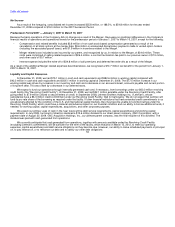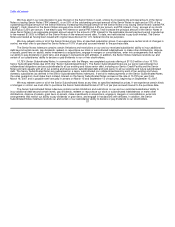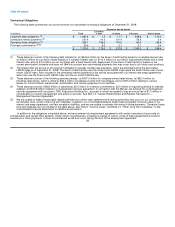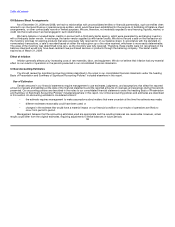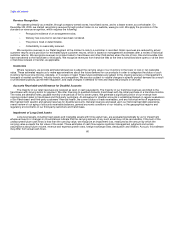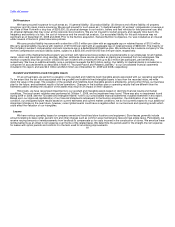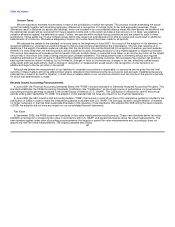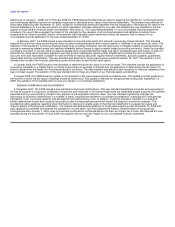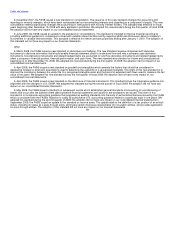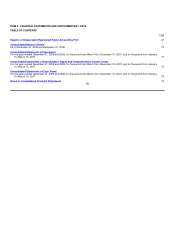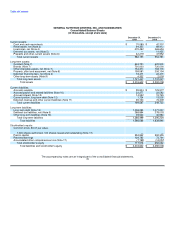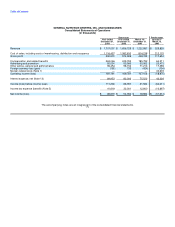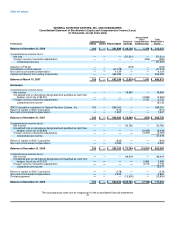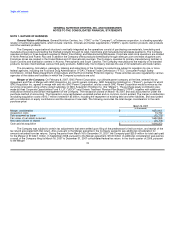GNC 2010 Annual Report Download - page 70
Download and view the complete annual report
Please find page 70 of the 2010 GNC annual report below. You can navigate through the pages in the report by either clicking on the pages listed below, or by using the keyword search tool below to find specific information within the annual report.
Table of Contents
In December 2007, the FASB issued a new standard on consolidation. The issuance of this new standard changes the accounting and
reporting for minority interests, which have been recharacterized as noncontrolling interests and classified as a component of equity. This new
consolidation method significantly changes the accounting for transactions with minority interest holders. The standard was effective for fiscal
years beginning after December 15, 2008 with early application prohibited. We adopted this new standard during the first quarter of fiscal 2009;
the adoption did not have any impact on our consolidated financial statements.
In June 2009, the FASB issued an update to the standard on consolidations. The standard is intended to improve financial reporting by
providing additional guidance to companies involved with variable interest entities and by requiring additional disclosures about a company's
involvement in variable interest entities. This standard is effective for interim and annual periods ending after January 1, 2010. The adoption of
this standard will not have any impact on our financial statements.
Other
In March 2008, the FASB issued a new standard on derivatives and hedging. The new standard requires companies with derivative
instruments to disclose information that should enable financial statement users to understand how and why a company uses derivative
instruments, how derivative instruments and related hedged items are accounted for and how derivative instruments and related hedged items
affect a company's financial position, financial performance, and cash flows. The new standard was effective for interim and annual periods
beginning on or after November 15, 2008. We adopted this new standard during the first quarter of 2009; the adoption had no impact on our
consolidated financial statements.
In April 2008, the FASB issued a new standard on goodwill and intangibles which amends the factors that should be considered in
developing renewal or extension assumptions used to determine the useful life of a recognized intangible. The intent of this new standard is to
improve the consistency between the useful life of a recognized intangible asset and the period of expected cash flows used to measure the fair
value of the asset. We adopted this new standard during the first quarter of fiscal 2009; the adoption did not have a any impact on our
consolidated financial statements.
In April 2009, the FASB issued a new standard on the disclosure of financial instruments. This standard brings the interpretive guidance into
alignment with the changes in U.S. GAAP. We adopted this standard during the second quarter of fiscal 2009; the adoption did not have any
impact on our consolidated financial statements.
In May 2009, the FASB issued a standard on subsequent events which establishes general standards of accounting for and disclosing of
events that occur after the balance sheet date but before financial statements are issued or are available to be issued. The intent of this
standard is to incorporate accounting guidance that originated as auditing standards into the body of authoritative literature issued by the FASB
which is consistent with the FASB's objective to codify all authoritative U.S. accounting guidance related to a particular topic in one place. We
adopted this standard during the second quarter of 2009; the adoption did not have any impact on our consolidated financial statements.In
September 2009, the FASB issued an update to the standard on income taxes. This update adds to the definition of a tax position of an entity's
status, including its status as a pass-through entity, eliminates certain disclosure requirements for non-public entities, and provides application
for pass-through entities. The adoption of this standard did not have any impact on our financial statements.
64


